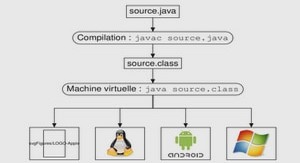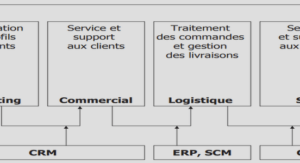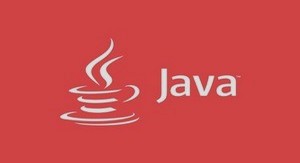Extrait du course and tutorial using Java with MySQL
Architectures
The client side may consist of only HTML and a web browser—athin client—or may contain compiled Java code in client-side web application modules. Server-side components may reside on any number of servers, often in server plug-ins called containers. One or more servers will host the database. Server software will have to include database drivers and their APIs.
On the client side or tier, the Java platform has two parts, the Java Application Program-ming Interface(API), and the Java Virtual Machine(JVM). From a .javasource file, the Java compiler writes a .classfile containing executable bytecodes. The JVM executes these bytecode sequences. The existence of a JVM for an operating system makes it possible for any machine running that OS to run any Java program. Whence the slogan, « write once, run everywhere », or as cynics say, « write once, debug everywhere ».Server tiers(Fig 14-1) may include web servers, application servers and database servers.
Servers deliver Java modules to clients in various forms. When there are multiple database servers, data may be packaged for delivery to clients in Enterprise JavaBeans (EJB), in which case the beans generally reside on a business tier, the databases to which the EJBs relate likely reside in a separate database tier, and the web tierprobably hosts small Java programs, Java Server Pages(JSPs) and servlets communicating with web clients, and optional clientside JavaBeans. Servlets and JSPs must run in HTTP plugin servlet containers. Sun maintains a list of available servlet containers here.
Pieces of the puzzle
To developMySQL-driven Java web applications, you need to get as many as seven moving (but free) parts working together:
• the client-side Java bundle, Java 2 Standard Edition (J2SE);
• the server-side Java bundle, Java 2 Enterprise Edition (J2EE);
• a web server, for example Apache (*Nix, Solaris, Windows), Internet Information Server (IIS, Windows), Sun Application Server (Linux/Unix, Solaris, Windows);
• for many web servers including Apache, you need a servlet container, for example Tomcat;
• the MySQL-Java JDBC driver,Connector/J;
• for connection pooling in webapps you need either pooling resources from your application server or container, or a freestanding connection pool resource like Jakarta Commons DBCP;
• for all but the simplest projects, you need an integrated development environment like IBM’s Eclipse or Sun’s NetBeans.
…….
Course and tutorial using Java with MySQL (134 KO) (Cours PDF)




